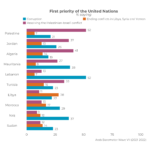When do demonstrations become a revolution? We romanticise the failures of the Arab Spring. But success has its costs, too. In the modern Middle East, only the Iranian Revolution has succeeded in bringing a new ruling class to power. But the 1979 revolution failed to bring about what the philosopher Michel Foucault predicted would be a new political dawn – instead, it marked the eclipse of both Persian constitutionalism and the republican nationalism of former prime minister Muhammed Mossadeq.
In the Arab world, there has been no equivalent. The series of revolutions from 1949 in Syria to 1969 in Libya were military coups, while the Arab Spring was followed by a rebooted authoritarianism across the region. There are now new mass uprisings in four countries that were largely spared in 2011 – Algeria, Sudan, Iraq and Lebanon. Will it be different this time?
Surveys such as the Arab Barometer and the demonstrators themselves tell us that the underlying discontents are the same as in 2011: corruption, oppressive and incompetent government and the absence of meaningful opportunities for youthful populations (the median age in Sudan is 19, in Iraq 21, in Algeria 28 and in Lebanon 29). Since 2014, oil prices have halved and economic growth has slowed. Public debt, youth unemployment and environmental degradation have increased….
Read full article here.


